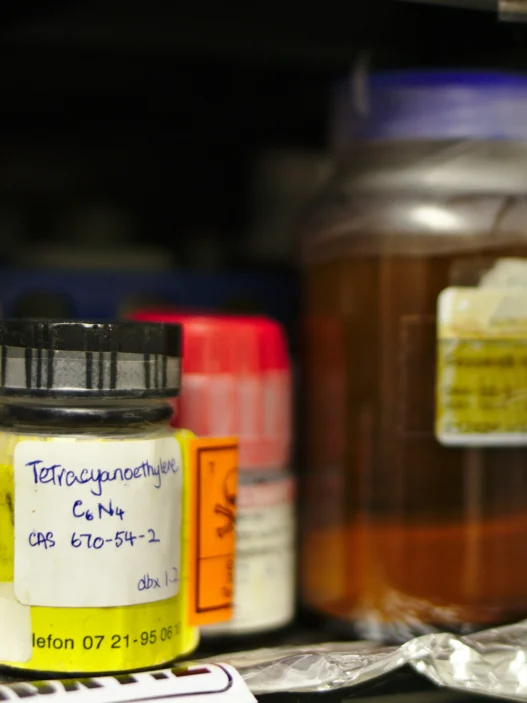N-Butyldiethanolamine is a chemical compound that has widespread applications across various industries, including pharmaceuticals, cosmetics, and agriculture. In everyday life, this compound is commonly used as an emulsifier in skincare products, as a corrosion inhibitor in metalworking fluids, and as a surfactant in household cleaning products. Its versatility and effectiveness make it an important ingredient in many everyday products that we use and rely on.
Table of Contents:
- 💡 Commercial Applications
- ⚗️ Chemical & Physical Properties
- 🏭 Production & Procurement
- ⚠️ Safety Considerations
- 🔬 Potential Research Directions
- 🧪 Related Compounds
💡 Commercial Applications
N-Butyldiethanolamine, also known as N-BDEA or BDAE, finds extensive commercial and industrial applications due to its properties as a versatile chemical intermediate. It is commonly used as a corrosion inhibitor and surfactant in metalworking fluids, coatings, and textile auxiliaries. Furthermore, N-BDEA is utilized in the synthesis of pharmaceuticals, agrochemicals, and personal care products.
In the realm of drug and medication applications, N-Butyldiethanolamine has shown promise as an ingredient in topical formulations for the treatment of skin conditions such as eczema and psoriasis. Its emollient properties make it an effective moisturizer, while its solubilizing capabilities aid in enhancing the delivery of active pharmaceutical ingredients. Additionally, N-BDEA is being explored for its potential use in transdermal drug delivery systems.
The unique combination of properties exhibited by N-Butyldiethanolamine makes it a valuable asset in various commercial, industrial, and pharmaceutical applications. Its versatility as a corrosion inhibitor, surfactant, and emollient underscores its importance in multiple industries. Ongoing research into its potential in drug delivery systems further highlights the multifaceted nature of this compound and its wide-ranging impact on different sectors.
⚗️ Chemical & Physical Properties
N-Butyldiethanolamine is a colorless to pale yellow liquid with a faint amine-like odor. It is typically stored in a cool, dry place away from direct sunlight to prevent any degradation of the compound’s properties.
With a molar mass of approximately 161.27 g/mol and a density of about 0.92 g/cm3, N-Butyldiethanolamine is comparable in molar mass to common food items such as sugar (180.16 g/mol) and in density to olive oil (0.92 g/cm3).
N-Butyldiethanolamine has a melting point of around -42°C and a boiling point of approximately 239°C. This puts it in a similar range to common food items like butter (melting point of 32°C) and water (boiling point of 100°C).
N-Butyldiethanolamine is soluble in water in certain proportions and has a moderate viscosity. This sets it apart from common food items like salt, which is highly soluble in water, and honey, which has a high viscosity.
🏭 Production & Procurement
N-Butyldiethanolamine is typically produced through the reaction of butanol and diethanolamine in the presence of a suitable catalyst. The synthesis of this compound involves careful control of temperature and pressure to ensure the desired product is obtained. Various purification methods may be employed to isolate the N-Butyldiethanolamine in its pure form.
Procuring N-Butyldiethanolamine involves sourcing the necessary raw materials, such as butanol and diethanolamine, from chemical suppliers. Once the compound is produced, it can be transported in sealed containers to prevent contamination or degradation during transit. Depending on the quantity needed, N-Butyldiethanolamine may be shipped in drums, totes, or tankers to industrial users.
Industrial users of N-Butyldiethanolamine can procure the compound directly from manufacturers or through chemical distributors. Quality control measures should be in place to ensure the purity and consistency of the product received. Proper handling and storage procedures should be followed to maintain the integrity of the N-Butyldiethanolamine until it is used in various industrial applications.
⚠️ Safety Considerations
Safety Considerations for N-Butyldiethanolamine:
N-Butyldiethanolamine should be handled with caution as it is a corrosive substance that can cause skin and eye irritation upon contact. Protective clothing, gloves, and eye protection should be worn when handling this chemical to prevent any adverse effects. In addition, it is important to work with N-Butyldiethanolamine in a well-ventilated area to minimize the risk of inhalation exposure.
Hazard Statements for N-Butyldiethanolamine:
N-Butyldiethanolamine can cause skin and eye irritation, and may be harmful if swallowed or inhaled. It is also a corrosive substance that can cause damage to the skin, eyes, and respiratory system upon prolonged exposure. Furthermore, N-Butyldiethanolamine may be harmful to aquatic life if released into the environment.
Precautionary Statements for N-Butyldiethanolamine:
When working with N-Butyldiethanolamine, it is recommended to wear protective gloves, clothing, and eye protection to prevent skin and eye irritation. In addition, it is important to work in a well-ventilated area and avoid breathing in vapors or mists of the chemical. If accidental exposure occurs, seek medical attention immediately and provide the Safety Data Sheet for N-Butyldiethanolamine to healthcare professionals.
🔬 Potential Research Directions
Potential research directions for N-Butyldiethanolamine include exploring its use as a corrosion inhibitor in various industries, such as oil and gas or metal processing.
Further research could investigate the effectiveness of N-Butyldiethanolamine as a surfactant in formulations for personal care products or household cleaners.
Studies may also focus on the environmental impact of N-Butyldiethanolamine and its degradation products, as well as its toxicity levels in relation to human health and the ecosystem.
🧪 Related Compounds
One similar compound to N-Butyldiethanolamine based upon molecular structure is N-Ethyldiethanolamine. This compound has a similar structure to N-Butyldiethanolamine, with an ethanolamine group attached to an ethyl group. In N-Ethyldiethanolamine, the butyl group in N-Butyldiethanolamine is replaced by an ethyl group.
Another compound with a similar structure to N-Butyldiethanolamine is N-Propyldiethanolamine. In this compound, the butyl group in N-Butyldiethanolamine is replaced by a propyl group. Both N-Propyldiethanolamine and N-Butyldiethanolamine contain an ethanolamine group attached to an alkyl chain.
A third similar compound to N-Butyldiethanolamine is N-Pentyldiethanolamine. This compound has a structure similar to N-Butyldiethanolamine, with a pentyl group replacing the butyl group. Like N-Butyldiethanolamine, N-Pentyldiethanolamine contains an ethanolamine group attached to an alkyl chain.




